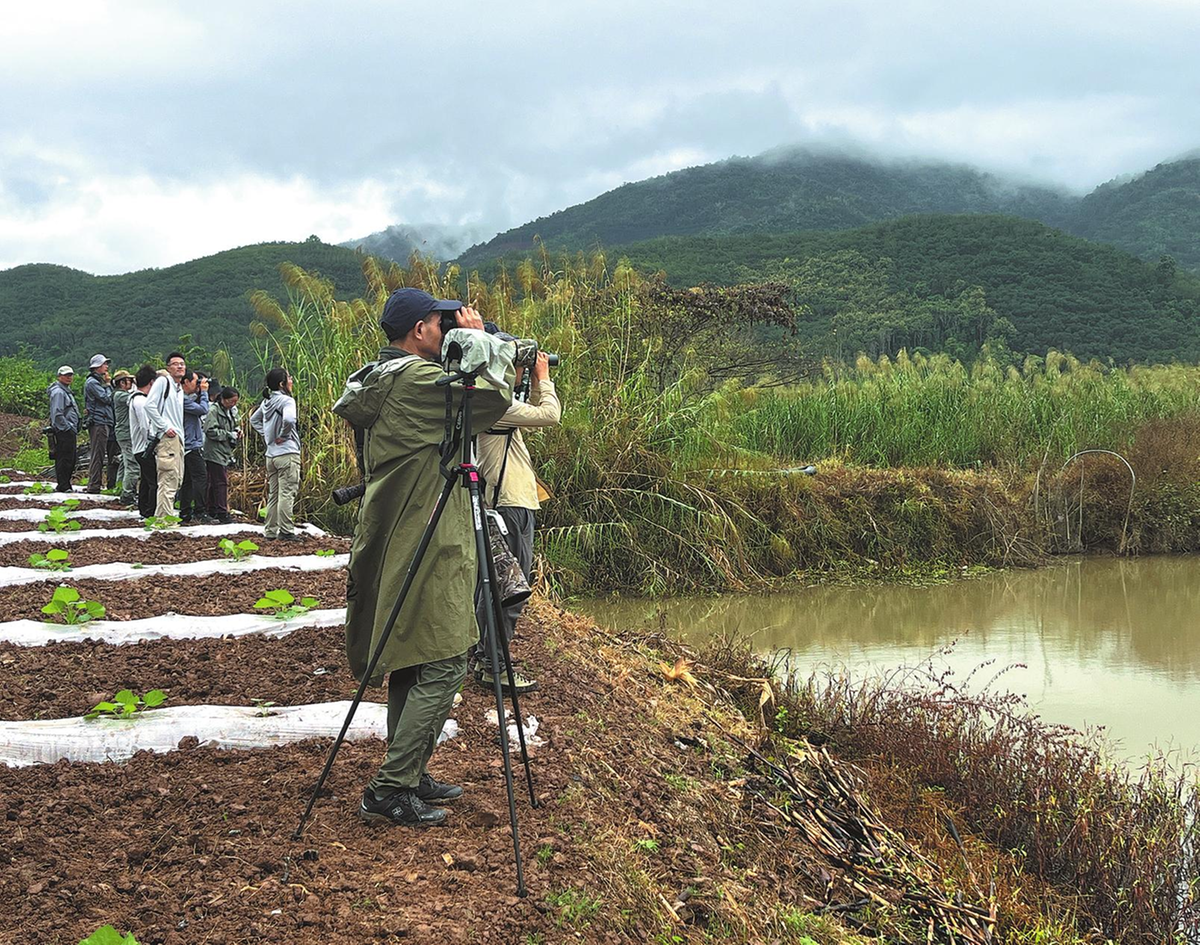
Despite the patchy rain and persistent mist, 45 keen bird-watchers, draped in raincoats, cameras, lenses and binoculars, set off into the wilds of the Lancang Lahu autonomous county in Southwest China's Yunnan province on Nov 1.
Their task, split into 12 teams, was to document as many bird species within the area within 60 hours. This, the second Yunnan Lancang Bird-watching Festival, held within the city of Pu'er, would yield some impressive results.
Almost three days later, when the teams emerged from the wilderness, a record 273 bird species had been identified, including seven species that had never been recorded in the area before, such as the elusive spotwinged starling.
The Yunnan Lancang Bird-watching Festival falls under the auspices of the "Our Yunnan" project, an endeavor launched in 2023 to fill data gaps in local wildlife, enhance conservation efforts and explore sustainable forest resource management practices that benefit local communities while protecting biodiversity.
This collaborative effort between governmental bodies, nongovernment organizations and corporate sponsors involves rigorous, field-based surveys to create an accurate snapshot of local wildlife populations.
Lu Wen, director of the Nuozhadu Provincial Nature Reserve in Pu'er, which extends into part of Lancang, said both iterations of the bird race so far have added new species to the area's list.
"Pu'er's existing bird checklist contains around 470 species," Lu said. "Prior to 2023, the reserve's own record stood at 233 species. The first Lancang bird race in 2023 had added 47 species to our checklist."
Lei Jinyu, secretary-general of the Rosefinch Center, a nonprofit dedicated to bird-watching and a key implementer of the "Our Lancang" project, told China Daily: "In less than three days, we documented more than half the bird species known to inhabit Pu'er and a significant portion of those found within the Nuozhadu reserve. This clearly shows that organizing a bird race is an exceptionally quick and effective method for conducting bird surveys."

Since the "Our Lancang" project's launch in 2022, supported by the Lancang county government, Huatai Futures Co and the Huatai Foundation, the initiative has concentrated on biodiversity monitoring in the area.
Speaking of the project, Pang Tao, project coordinator from the Shan Shui Conservation Center's Yunnan office, said it aims to fill data gaps and enhance wildlife surveys, providing scientific guidance for future conservation efforts. The Chinese NGO is dedicated to species and ecosystem conservation and addressing human-nature coexistence issues, and it manages the "Our Lancang" project.
The project also investigates sustainable forest resource management and biodiversity conservation practices, benefiting local communities and paving the way for ecotourism development, Pang added.
"We have installed 23 infrared cameras at various sites in Lancang to collect data," she said.
"However, the cameras can only monitor wild animals and a few large bird species. To gain a comprehensive understanding of the area's avian life, bird surveys are essential. The success of the first Lancang bird-watching festival inspired us to incorporate a bird race into our project areas."
Experienced birders
The bird-watching festival was co-organized by the Shan Shui center and the Rosefinch Center from Oct 31 to Nov 4. It was held under the guidance of the Lancang County Forestry and Grassland Bureau and the Nuozhadu reserve management bureau, with support from the Global Environment Facility's project on improving the sustainability of China's nature reserves.
Due to limited funds and a focus on conducting a thorough bird survey, the organizers, including Zhong Jia, one of the founders of the Rosefinch Center and a pioneer among the country's first group of birdwatchers, were able to invite only 10 teams comprising 40 bird-watchers to participate in the festival.

"Unlike many of our previous bird races where participants could voluntarily sign up, we chose to invite 10 experienced birders as the team leaders this time," she said. "They could choose their own teammates by themselves."
The team leaders included Yue Weiqiang, a seasoned birder from Guangzhou in Guangdong province who was a judge of a Guangdong bird race earlier this year, and Zhang Xuelian, a professional birdwatching tour leader from Kunming, capital of Yunnan.
"In addition to the 10 invited teams, the organizers and judges also joined forces to participate in the survey," Zhong said. "Although the festival does not offer awards for the winners, the competitive spirit among the birders motivated us to do our best."
ALSO READ: Yunnan's biodiversity nurtures miracles of nature
As the race got underway, some teams would leave the hotel as early as 5 am and return well after midnight.
The organizers recommended seven survey routes for the participants, encompassing three sections of the Lancang National Forest Park, the Lancang section of the Nuozhadu reserve, and the Jingmai Mountain World Heritage Site. Some of these routes extend over 50 kilometers and require a full day to explore.
As a result, the participating teams often found themselves working independently in the field.
During the three days of the festival, the local weather proved to be quite challenging, with intermittent showers and continuous drizzle throughout the event.
"Autumn is usually our dry season," Lu said. "This year the whole region is exceptionally wet."
Birding in such bad weather can be challenging, said Lei, who served as one of the judges for the festival. On the first day of the festival, he recorded just over 40 species, but surprisingly found that all the teams together had already recorded a total of 200 bird species.
Rich biodiversity
By the second day of the festival, the total number of bird species recorded had already reached 270. "The total record of the first Lancang bird festival was 231, and it was held mainly within the Nuozhadu reserve, which offers better protected habitats," Zhong said. "This result shows Lancang's extremely rich biodiversity."
Lancang, situated in southern Yunnan and bordering Myanmar, boasts a diverse elevation range from 600 meters to 2,200 meters. This varied landscape includes the Lancang River valley, wetlands such as ponds and terraced farmlands, economic forests such as tea forests on the Jingmai Mountain, and both original and secondary seasonal rainforests around the Nuozhadu reserve.
The timing of the bird festival aligns with the migration of many northern breeding birds moving south for the winter. These migratory birds mingle with local resident birds and summer visitors that haven't yet departed, offering both significant challenges and delightful surprises for the participating teams.

"You show up at different habitats and will find different birds," Lei said. "Because of the weather, the different timings of your visits to the same habitat might produce dramatically different sightings."
As a result, Zhong noted that 50 of the 273 bird species documented during the festival were recorded by only one team. More than 40 percent of the species were sighted by no more than four teams, and only 60 species were observed by most of the participating teams and could be considered locally common.
A low number of unique species suggests that bird-watching is relatively easy and species duplication is high, Zhong said.
On the other hand, a high number of unique species may indicate difficult bird-watching conditions such as birding in karst landscapes or in bad weather. It could also mean that the race area is large with significant elevation differences and with fewer teams spread out. "Our bird race falls into the latter category," she said.
Solid checklist
The sightings of so many unique species posed a challenge to the race's judges. "We need evidence to ensure the accuracy and reliability of our survey records," Lei said.
Fortunately, many teams watched birds with advanced birding gear. Besides binoculars and telescopes, many participants used cameras to take photos of the birds and night vision devices to find birds in the evenings.
Yue Weiqiang's team of four Guangdong birders brought three night vision devices.
"We used them for night watching every day," Yue said. "It was exhausting but rewarding."
With the support of the devices, the teams recorded seven species of owls and two species of nightjars during the event, Zhong said.
A team from Beijing focused more on collecting sound evidence to prove their records.
The team leader, Li Juefei, would start recording environmental sounds while birding in the wild.
"I usually keep my recorder running all day long," he said.
"Once I hear a special bird call or song, I stop the recorder, leave a mark, and start recording again. This way, I can easily find the soundtrack later and examine it more carefully."
This method allowed them to capture unique vocalizations, providing another layer of verification for their sightings.
During the race, Li and his teammates recorded a total of 158 bird species, about 20-30 species only heard. They presented bird sound voiceprints of a few species to the judges as their evidence, which was challenging for the judges.
Han Lianxian, a retired professor from Southwest Forestry University in Kunming and a renowned ornithologist, said that few people can quickly identify a bird just based on a voiceprint. Solid evidence for a new record must include photos, he said.
"Bird-watching should involve watching, not just listening," Han said during his remarks at the closing ceremony of the event.
"First, it can verify that the call you initially heard was correct and indeed belonged to that bird. Second, bird-watching has always been about comprehensive observation — color, shape, behavior, calls and more. It's about gaining a holistic understanding of a bird, and missing any aspect would be regrettable."
Even though the judges didn't approve some 40 of the species presented by the teams, the bird race produced seven new recorded species for the area. All of them with photo evidence.
Zhang Xuelian and her team discovered a male spot-winged starling among a flock of nearly 100 chestnut-tailed starlings on farmland near Mengkuang village late in the afternoon on Nov 3. This rare species was chosen as the festival's top bird. Zhang shared the location of their sighting with other festival participants.
As the festival's closing ceremony took place in the village's newly built square on Nov 4, many participants flocked to the farmland, eager to catch a glimpse of the starling. Some were fortunate enough to spot it before the ceremony, while others had to try again afterward.
Ultimately, most bird-watchers succeeded in seeing the bird, which was a "lifer" (a new species) for many of them. "Bird-watching is often a hobby full of missed opportunities, but sometimes it rewards us with a happy ending," Lei said.


